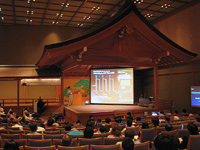
The CREST “Nano-interface Technology” research area held a joint symposium on the results of research of this project on nano-interface chemistry over two days of the V ISMSC 2010. The total number of participants at V ISMSC was over 400: As many as 40% of them were from overseas, thus revealing the activity and high interest in the relevant field. The level of enthusiasm at the conference held in Japan to reveal the Japanese chemistry taking place such as in the CREST project led to top-level researchers recognizing the level of chemistry in Japan, thereby leading to the promotion of domestic research by providing feedback from discussions and the activation of young researchers in terms of future developments.
The joint symposium presented the results of research on CREST nano-interface chemistry to the public at an international conference that brought together all the cutting-edge researchers in the relevant field from both Japan and overseas, with questions and answers and discussions on the experimental results then taking place in the communication corner after the lecture. The results of the project were highly evaluated. The high international position of the project was clarified through a lecture on the results of a research field that is deeply related to the project which took place at the same session and discussions. Moreover, many expectations were also expressed for future deployments to take place.
The lectures at this session were held in one venue where all the participants gathered together from fields related to macrocyclic molecules and super-molecules, and in particular those involved in important fundamental research on nano-interface technology. For example, Professor Stefan Matile from the University of Geneva was invited as the keynote lecture. Professor Matile introduced some extremely high quality research on building ion channels on an interface that consists of a lipid bilayer membrane and that can control responses through optical stimulation. Professor Nobuo Kimizuka (Kyushu University), Professor Hiroshi Kitagawa (Kyoto University), Professor Nobuhiko Yui (Japan Advanced Institute of Science and Technology), and Dr. Shinji Inagaki (Toyota Central R&D Labs., Inc.) were also invited as lecturers from the nano-interface field to present the latest results of research in the nano-interface research area.
As additional information Mr. Ichimaru, the counselor general of the Innovation Headquarters, JST, introduced several JST projects on the first day of the joint symposium: JST was thus able to play a role in this international conference as a promotional activity for JST projects overseas.
JST, an integrated organization of science and technology in Japan, establishes an infrastructure for the entire process from the creation of knowledge to the return to the society. For more information, visit http://www.jst.go.jp/EN/